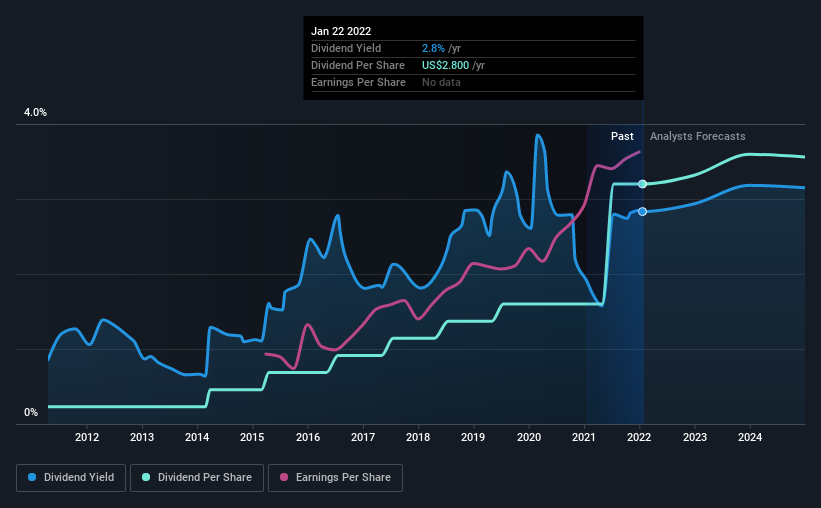Why You Might Be Interested In Morgan Stanley (NYSE:MS) For Its Upcoming Dividend
It looks like Morgan Stanley (NYSE:MS) is about to go ex-dividend in the next four days. The ex-dividend date occurs one day before the record date which is the day on which shareholders need to be on the company's books in order to receive a dividend. The ex-dividend date is important as the process of settlement involves two full business days. So if you miss that date, you would not show up on the company's books on the record date. In other words, investors can purchase Morgan Stanley's shares before the 28th of January in order to be eligible for the dividend, which will be paid on the 15th of February.
The company's upcoming dividend is US$0.70 a share, following on from the last 12 months, when the company distributed a total of US$2.80 per share to shareholders. Based on the last year's worth of payments, Morgan Stanley stock has a trailing yield of around 2.8% on the current share price of $98.86. We love seeing companies pay a dividend, but it's also important to be sure that laying the golden eggs isn't going to kill our golden goose! As a result, readers should always check whether Morgan Stanley has been able to grow its dividends, or if the dividend might be cut.
See our latest analysis for Morgan Stanley
If a company pays out more in dividends than it earned, then the dividend might become unsustainable - hardly an ideal situation. Fortunately Morgan Stanley's payout ratio is modest, at just 30% of profit.
Companies that pay out less in dividends than they earn in profits generally have more sustainable dividends. The lower the payout ratio, the more wiggle room the business has before it could be forced to cut the dividend.
Click here to see the company's payout ratio, plus analyst estimates of its future dividends.
Have Earnings And Dividends Been Growing?
Companies with consistently growing earnings per share generally make the best dividend stocks, as they usually find it easier to grow dividends per share. Investors love dividends, so if earnings fall and the dividend is reduced, expect a stock to be sold off heavily at the same time. That's why it's comforting to see Morgan Stanley's earnings have been skyrocketing, up 23% per annum for the past five years.
Many investors will assess a company's dividend performance by evaluating how much the dividend payments have changed over time. In the past 10 years, Morgan Stanley has increased its dividend at approximately 30% a year on average. Both per-share earnings and dividends have both been growing rapidly in recent times, which is great to see.
Final Takeaway
Is Morgan Stanley an attractive dividend stock, or better left on the shelf? Companies like Morgan Stanley that are growing rapidly and paying out a low fraction of earnings, are usually reinvesting heavily in their business. This is one of the most attractive investment combinations under this analysis, as it can create substantial value for investors over the long run. Overall, Morgan Stanley looks like a promising dividend stock in this analysis, and we think it would be worth investigating further.
On that note, you'll want to research what risks Morgan Stanley is facing. For instance, we've identified 2 warning signs for Morgan Stanley (1 is a bit concerning) you should be aware of.
If you're in the market for dividend stocks, we recommend checking our list of top dividend stocks with a greater than 2% yield and an upcoming dividend.
Have feedback on this article? Concerned about the content? Get in touch with us directly. Alternatively, email editorial-team (at) simplywallst.com.
This article by Simply Wall St is general in nature. We provide commentary based on historical data and analyst forecasts only using an unbiased methodology and our articles are not intended to be financial advice. It does not constitute a recommendation to buy or sell any stock, and does not take account of your objectives, or your financial situation. We aim to bring you long-term focused analysis driven by fundamental data. Note that our analysis may not factor in the latest price-sensitive company announcements or qualitative material. Simply Wall St has no position in any stocks mentioned.



